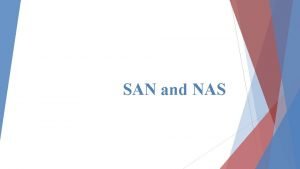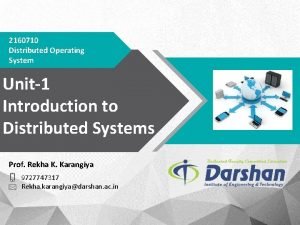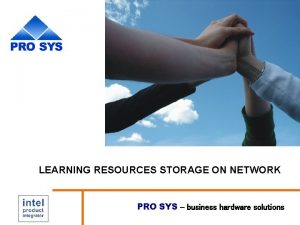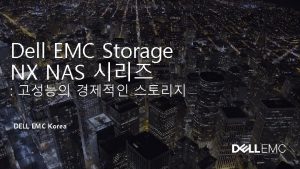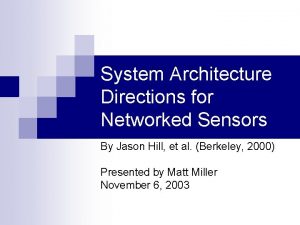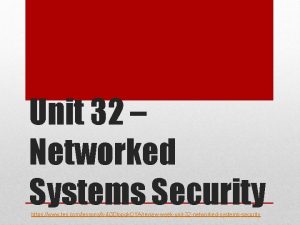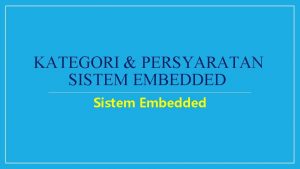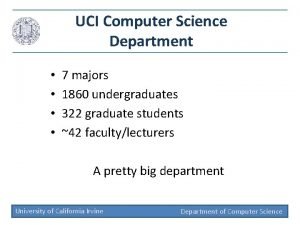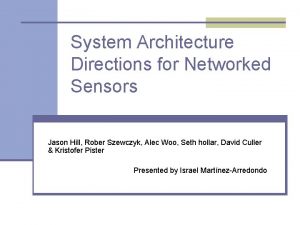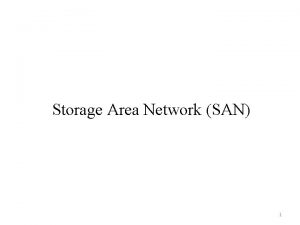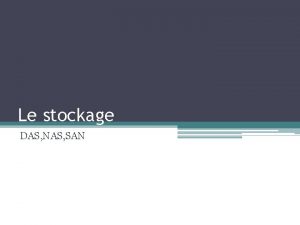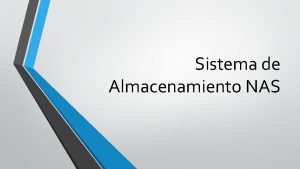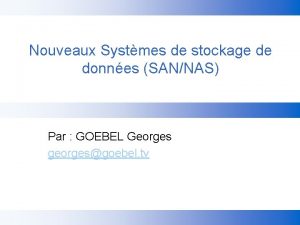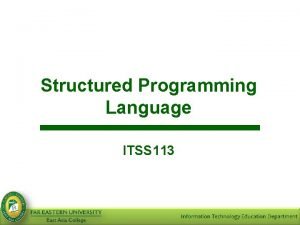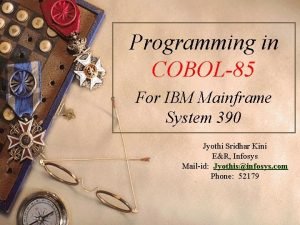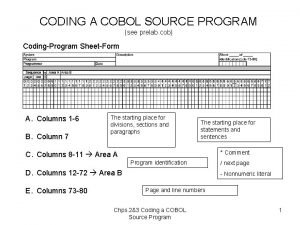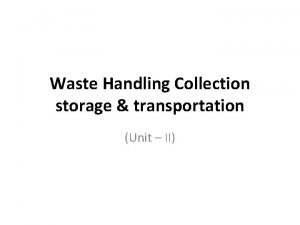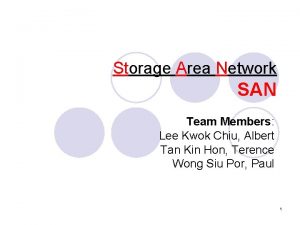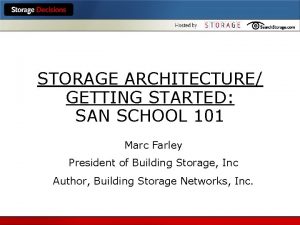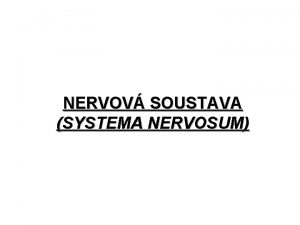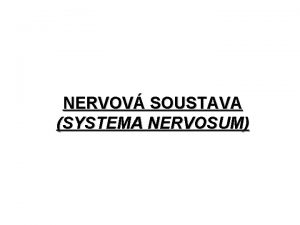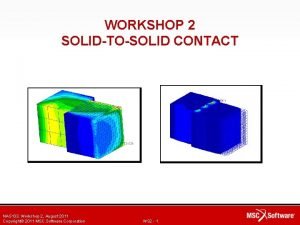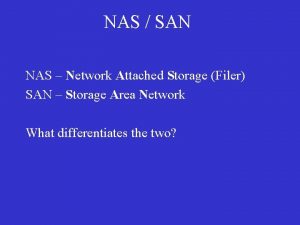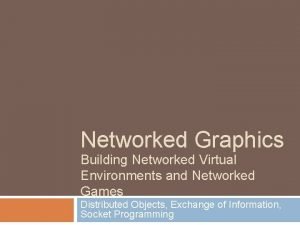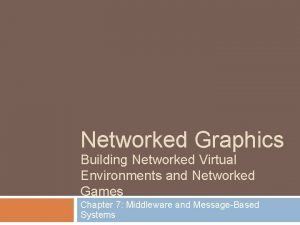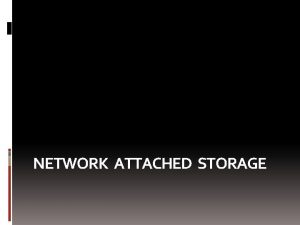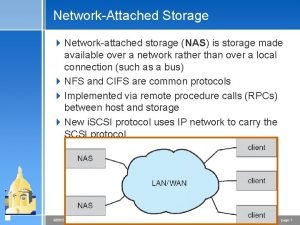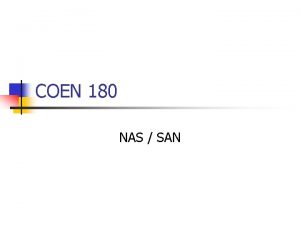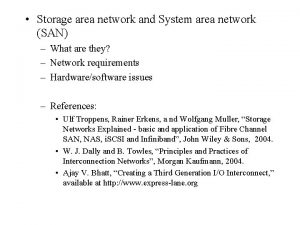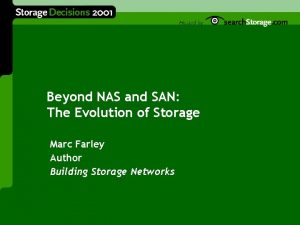Networked Storage SAN and NAS SAN Storage Area
























































- Slides: 56

Networked Storage SAN and NAS

SAN Storage Area Network http: //en. wikipedia. org/wiki/Storage_area_network

Storage Area Network (SAN) n An architecture to attach (remote) computer storage devices to servers ¨ Devices appear as locally attached to the operating system n disk arrays, tape libraries, optical jukeboxes, etc. ¨ Device may be near, but not physically in the server like local storage is n Device may be remote ¨ Cost and complexity is dropping n SANs are still uncommon outside larger enterprises

Storage Area Network (SAN) Works at the disk address level (block) n NAS contrasted to a SAN: n ¨ network-attached n storage (NAS) uses file-based protocols ¨ E. g. NFS or SMB/CIFS It is clear that the storage is remote n Computers request an abstract file rather than a disk block n

SAN Network types

Network types n Most storage networks use the SCSI protocol for communication between servers and disk drive devices ¨ Does not use the SCSI low-level physical interface (e. g. electronics and cables) n Its bus topology is unsuitable for networking

Network types n To form a network, a mapping layer is used to other low-level protocols: ¨ Fibre Channel Protocol (FCP) n Maps SCSI over Fibre Channel n Currently the most common. ¨ i. SCSI n Maps SCSI over TCP/IP ¨ Hyper. SCSI n Maps SCSI over Ethernet ¨ FICON n Maps over Fibre Channel (used by mainframe computers) ¨ ATA over Ethernet n Mapping ATA over Ethernet ¨ SCSI and/or TCP/IP mapping over Infini. Band (IB)

SAN Storage sharing

Storage sharing n SAN market Driving forces: ¨ ¨ Rapid growth of highly transactional data Requires high speed, block-level access to hard drives n n Historically ¨ ¨ Enterprises created "islands" of high performance SCSI disk arrays Each island was dedicated to a different application and visible as a number of "virtual hard drives" n n n Data from email servers Databases High usage file servers LUNs (Logical Unit Numbers) SAN essentially connected those storage islands using a high-speed network Operating system sees a SAN as a collection of LUNs ¨ Each maintains its own file systems on them

Storage sharing n Most reliable and most widely used are the local file systems ¨ Cannot be shared among multiple hosts ¨ If two independent local file systems resided on a shared LUN, they would be unaware of the fact n n Have no means of cache synchronization Eventually would corrupt each other ¨ Sharing data between computers through a SAN requires advanced solutions n n SAN file systems Clustered computing

Storage sharing n Despite such issues, SANs help to increase storage capacity utilization ¨ Multiple servers share the same growth reserve on disk arrays n In contrast, NAS allows many computers to access the same file system over the network and synchronizes their accesses ¨ Lately, the introduction of NAS heads allowed easy conversion of SAN storage to NAS

SAN Benefits

Benefits n Sharing storage usually: ¨ Simplifies storage administration ¨ Adds flexibility n Cables and storage devices do not have to be physically moved to move storage from one server to another n Side note: ¨ Spring 2016: 1 petabyte n ~ $50, 000 to $500, 000 n Depending on speed, backup, etc. n Aberdeen 1 PB SAN: $375, 000 ¨ ¨ High reliability Expandable to 4. 3 PB

Benefits n Other benefits include ¨ Ability itself n Allows for a quick and easy replacement of faulty servers ¨ n The SAN can be reconfigured so that a replacement server can use the LUN of the faulty server Process can take as little as half an hour ¨ n to allow servers to boot from the SAN Relatively new idea being pioneered in newer data centers Number of emerging products designed to facilitate and speed up this process still further

Benefits n More effective disaster recovery processes SAN can span a distant location containing a secondary storage array ¨ Enables storage replication either implemented by ¨ n n n ¨ IP WANs are often least costly method of long-distance transport n ¨ Fibre Channel over IP (FCIP) and i. SCSI protocols have been developed to allow SAN extension over IP networks Traditional physical SCSI layer could only support a few meters n ¨ disk array controllers server software specialized SAN devices not nearly enough to ensure business continuance in a disaster. Demand for this SAN application has increased dramatically after the September 11 th attacks in the United States, and increased regulatory requirements associated with Sarbanes-Oxley and similar legislation.

Benefits n Consolidation of disk arrays economically accelerated advancement of some of their advanced features: ¨ I/O caching ¨ Snapshotting ¨ Volume cloning n Business Continuance Volumes or BCVs

SAN infrastructure

SAN infrastructure n SANs often utilize a Fibre Channel fabric topology ¨ Infrastructure specially designed to handle storage communications ¨ Provides faster and more reliable access than higherlevel protocols used in NAS ¨ A fabric: n ¨A Similar in concept to a network segment in a local area network typical Fibre Channel SAN fabric is made up of a number of Fibre Channel switches.

Fibre Channel/Fabric Example

SAN infrastructure n All major SAN equipment vendors also offer some form of Fibre Channel routing solution ¨ Bring substantial scalability benefits to the SAN architecture n n n Allows data to cross between different fabrics without merging them Use proprietary protocol elements Top-level architectures being promoted are radically different ¨ Often enable mapping Fibre Channel traffic over IP or over SONET/SDH

SAN Compatibility

Compatibility n Early problems with Fibre Channel SANs ¨ Switches and other hardware from different manufacturers were not entirely compatible ¨ Basic storage protocols FCP were standard n Some of the higher-level functions did not interoperate well. ¨ Many host operating systems would react badly to other operating systems sharing the same fabric ¨ Many solutions were: n n Pushed to the market before standards were finalized Vendors innovated around the standards.

Compatibility n n The combined efforts of the members of the Storage Networking Industry Association (SNIA) improved the situation during 2002 and 2003 Today most vendor devices interoperate nicely ¨ There are still many high-level functions that do not work between different manufacturers’ hardware

SAN SANs in the Media and Entertainment

SAN Storage virtualization and SANs

Storage virtualization and SANs n Storage virtualization ¨ n The physical storage resources are aggregated into storage pools ¨ n Transparently handles the process of mapping it to the actual physical location Naturally implemented inside each modern disk array ¨ n Logical storage is created from the pool Presents the user a logical space for data storage ¨ n Process of completely abstracting logical storage from physical storage Using vendor's proprietary solution Goal is to virtualize multiple disk arrays into a single monolithic storage device ¨ ¨ ¨ Made by different vendors Scattered over the network Can be managed uniformly

SAN Last note n SANs usually have their own network ¨ Kept separate from the “normal” network High speed n Kept physically secure n ¨ Don’t slow down with encryption, etc

NAS Network Attached Storage http: //en. wikipedia. org/wiki/Net work-attached_storage

Network-attached storage (NAS) n A file-level computer data storage ¨ Connected to a computer network ¨ Providing data access to heterogeneous network clients

NAS Description

Description n NAS hardware is similar to the traditional file server equipped with direct attached storage (DAS) ¨ Differs considerably on the software side ¨ Operating system and other software on the provides: n n n NAS unit Data storage Data access Management of these functionalities ¨ Use of NAS devices for other purposes is discouraged ¨ Many vendors also purposely make it hard to develop or install any third-party software on their NAS device n n Use closed source operating systems and protocol implementations Basically, NAS devices are server appliances

Description n NAS units are commonly controeled through a web interface ¨ As n opposed to monitor/keyboard/mouse Minimal-functionality or stripped-down operating systems are used on NAS devices ¨ E. g. Free. NAS is in fact a "leaned-out" version of Free. BSD n An open source NAS software meant to be deployed on standard computer hardware

Description n NAS systems usually contain one or more hard disks ¨ Arranged RAIDs n into logical, redundant storage containers or Same as traditional file servers ¨ NAS removes the responsibility of file serving from other servers on the network n NAS uses file-based protocols such as ¨ NFS (popular on UNIX systems) ¨ SMB (Server Message Block) (MS Windows systems) ¨ NAS units rarely limit clients to only one protocol

Description NAS provides both storage and filesystem n Often contrasted with SAN n ¨ Provides only block-based storage ¨ Filesystem concerns left for the "client" side

Description n Boundaries between NAS and SAN systems starting to overlap ¨ Some n products making the obvious next evolution Offering both file level protocols (NAS) and block level protocols (SAN) from the same system. ¨ However a SAN device is usually served through NAS as one large flat file, not as a file system per se. ¨ An example of this is Openfiler, a free product running on Linux


NAS History

History n n n Network-attached storage introduced with the early file sharing Novell's Net. Ware server operating system and NCP protocol in 1983 Sun Microsystems' 1984 release of NFS allowed network servers to share their storage space with networked clients 3 Com's 3 Server and 3+Share software First purpose-built servers (including proprietary hardware, software, and multiple disks) for open systems servers ¨ Led the segment from 1985 through the early 1990 s ¨ n 3 Com and Microsoft developed LAN Manager software and protocol to further this new market

History n n Inspired by the success of file servers from Novell, IBM, and Sun, several firms developed dedicated file servers Auspex Systems ¨ One of the first to develop a dedicated NFS server for use in the UNIX market ¨ A group of Auspex engineers split away to create the integrated Network Appliance "filer“ n n Supported both Windows and UNIX, in the early 1990 s, starting the market for proprietary NAS arrays. Starting in the early 2000 s, a series of startups emerged offering alternative solutions to single filer solutions in the form of clustered NAS

NAS Benefits

Benefits n n Availability of data might potentially be increased with NAS if it provides built-in RAID and clustering Performance can be increased by NAS because the file serving is done by the NAS ¨ Not done by a server responsible for also doing other processing ¨ Performance of NAS devices depends heavily on n n The speed of and traffic on the network The amount of cache memory (RAM) on the NAS computers or devices

NAS Benefits n Note that a NAS is basically a server: ¨ All n major components of a typical PC CPU, Motherboard, RAM, etc. ¨ Reliability is a function of how well it is designed ¨ Note: n NAS without redundant; ¨ ¨ ¨ n Data access paths Redundant controllers Redundant power supplies Usually less reliable than Direct Attached Storage (DAS) connected to a server ¨ Typically does not have redundancy for its major components

NAS Drawbacks

Drawbacks n Due to the multiprotocol, and the reduced CPU and OS layer, the NAS has its limitations compared to the DAS/FC systems DAS: Direct Attached Storage ¨ FC: Fibre Channel ¨ n NAS reaches performance limitations if: NAS is occupied with too many users ¨ too many I/O operations ¨ CPU processing power that is too demanding ¨ n A server system is easily upgraded Adding one or more servers into a cluster ¨ CPU power can be upgraded ¨ NAS is limited to its own hardware, typically not upgradeable ¨

Drawbacks n NAS may also fail to expose well-known services that are typical of a file server, or enable them in a way that is not efficient ¨ Examples are: n Ability to compute disk usage of separate directories n Ability to index files rapidly (locate) n Ability to mirrorize efficiently with rsync ¨ You may still rsync, but through a NFS client n That method fails to enumerate huge file hierarchies at the nominal speed of local drives n Induces significant network traffic

Drawbacks n Key differences between DAS and NAS: ¨ DAS is simply an extension to an existing server and is not “networked” ¨ NAS sits on a network as its own entity It is easier to share files with NAS n NAS typically has less CPU and I/O power compared to DAS n

NAS uses

NAS uses n n NAS is useful for more than just general centralized storage provided to client computers in environments with large amounts of data. NAS can enable simpler and lower cost systems such as load-balancing and fault-tolerant email and web server systems by providing storage services. The potential emerging market for NAS is the consumer market where there is a large amount of multi-media data. Such consumer market appliances are now commonly available. ¨ n The price of NAS appliances has plummeted in recent years ¨ n n Unlike their rackmounted counterparts, they are generally packaged in smaller form factors. offering flexible network-based storage to the home consumer market for little more than the cost of a regular USB or Fire. Wire external hard disk. Many of these home consumer devices are built around ARM, Power. PC or MIPS processors running an embedded Linux operating system. More recently, home NAS devices have incorporated support for the Universal Plug and Play protocol, enabling them to serve the growing number of networked home media players.

Sample low-end products n https: //www. synology. com/en-us/ n http: //www. newegg. com/Product. List. aspx? Submit=ENE&DEPA=0& Order=BESTMATCH&N=-1&is. Node. Id=1&Description=synology&x=0&y=0 n Many vendors ¨ QNAP ¨ http: //www. drobo. com/

NAS heads

NAS heads n A NAS head refers to a NAS which does not have any on -board storage, but instead connects to a SAN ¨ In effect, it acts as a translator between n n File-level NAS protocols (NFS, CIFS, etc. ) Block-level SAN protocols (Fibre Channel, i. SCSI) It can combine the advantages of both technologies "NAS head" is sometimes also used to refer to the portion of a self-contained NAS system other than its storage ¨ An example would be the ONStor Bobcat

NAS operating systems for consumer PCs

NAS OSs n Open source NAS-oriented distributions of Linux and Free. BSD are also available Including Free. NAS, NASLite and Openfiler ¨ Easy to configure via a Web-based Interface and run on low-end conventional computers. ¨ n Can run from Live. CD ¨ Bootable USB flash drive ¨ One of the mounted hard drives ¨ n Run using Samba, NFS daemon, and FTP daemons ¨ Freely available for those operating systems

Summary

Summary n Both provide storage over a network ¨ SAN – Block based Unformatted n For one system/user n ¨ NAS – File based Formatted n Can be accessed by many systems/users n n World is converging

SAN and NAS serve the same function by sharing disc space on a network. A. B. True False
 Nas v san
Nas v san Introduction to san and nas storage
Introduction to san and nas storage ťapákovci v nás a okolo nás (diskusný príspevok)
ťapákovci v nás a okolo nás (diskusný príspevok) Distributed os definition
Distributed os definition Networked digital library of theses and dissertations ndltd
Networked digital library of theses and dissertations ndltd San storage area network
San storage area network Dell nas box
Dell nas box Networked insurance agents
Networked insurance agents System architecture directions for networked sensors
System architecture directions for networked sensors Unit 32 networked system security
Unit 32 networked system security Networked systems security
Networked systems security Fully networked vehicle
Fully networked vehicle Networked outdoor lighting
Networked outdoor lighting Kategori embedded system
Kategori embedded system Cs 151 uci
Cs 151 uci System architecture directions for networked sensors
System architecture directions for networked sensors Networked sensor array
Networked sensor array How to implement san storage
How to implement san storage Stockage das nas san
Stockage das nas san Diferencia entre nas y san
Diferencia entre nas y san Différence san nas
Différence san nas Primary storage and secondary storage
Primary storage and secondary storage Primary storage and secondary storage
Primary storage and secondary storage Uses rigid metallic platters
Uses rigid metallic platters Unified storage vs traditional storage
Unified storage vs traditional storage Cobol area a and area b
Cobol area a and area b Ibm system/390
Ibm system/390 Wet curved surface area
Wet curved surface area Cobol area a and area b
Cobol area a and area b Formula of lateral surface area of prism
Formula of lateral surface area of prism Lateral area and surface area
Lateral area and surface area Fish gastrulation
Fish gastrulation Find the lateral area and surface area of each prism
Find the lateral area and surface area of each prism Bmw storage area
Bmw storage area Storage area network tutorial
Storage area network tutorial Introduction to storage area networks
Introduction to storage area networks Emc san storage
Emc san storage San storage architecture
San storage architecture Area radicularis
Area radicularis Area vs surface area
Area vs surface area Edentulous mandible anatomy
Edentulous mandible anatomy Unit 11 review area and volume
Unit 11 review area and volume Filip barinka
Filip barinka Segmentová inervace těla
Segmentová inervace těla What is lateral area
What is lateral area How to find the surface area of a octagonal prism
How to find the surface area of a octagonal prism University of san francisco san jose campus
University of san francisco san jose campus Qué opinas acerca de san pedro y san pablo
Qué opinas acerca de san pedro y san pablo Istituto san giovanni bosco san salvatore telesino
Istituto san giovanni bosco san salvatore telesino Escuela de salud san pedro claver sede san antonio
Escuela de salud san pedro claver sede san antonio Evo nas pred tobom marijo
Evo nas pred tobom marijo Idi kaži cijelom svijetu tekst
Idi kaži cijelom svijetu tekst Nas bog on je silan bog i kralj tekst
Nas bog on je silan bog i kralj tekst Nas133
Nas133 Zbyškovi bylo smutno
Zbyškovi bylo smutno Moj isuse raskriljujem
Moj isuse raskriljujem Udžbenik iz informatike za 5 razred
Udžbenik iz informatike za 5 razred
